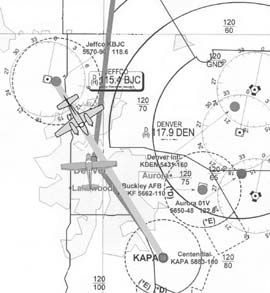
by Ken Ibold
Lots of pilots like to take to the air and find solitude and thereby freedom. For others, however, theres something strangely comforting about operating under the watchful eyes of an air traffic controller.
If you routinely fly in congested airspace – such as around Class B airports – or under IFR, the routine of having a controllers voice giving you vectors, clearances, traffic advisories and frequency changes eventually leads you into thinking the controller is a partner in your flight.
But as the old saw goes, you can get too much of a good thing. And the tendency to rely on a controller can lead to complacency.
On a beautiful winter day in Denver, the 20-year-old pilot of a Cessna 172 loaded two passengers into the rented airplane for a VFR flight from Centennial Airport to Cheyenne, Wyo. He had gotten his private certificate about six months earlier and had accumulated just over 127 hours of flight time.
The Cessna took off from Centennials runway 17L at 5:08 p.m. and was cleared to proceed VFR on course. The sun set a couple of minutes after takeoff. There were a few clouds at 8,000 feet – about 2,500 feet agl – but visibility was more than 10 miles.
As the Cessna climbed on a northward track, a Piper Cheyenne took off from Jeffco Airports runway 29R, en route to Centennial, about 25 miles away. In the turboprop were two pilots. The 57-year-old PIC was a commercial pilot with nearly 9,500 hours total time, including more than 2,000 multi time. The passenger on board was also a commercial pilot who had nearly 2,000 hours, including 850 multi time. Both were qualified to fly the Cheyenne.
The Cheyenne took off at 5:17 p.m. and the controller gave him a discrete transponder code. He identified the airplane on radar and told the pilot to continue on course. The controller noted there was no Mode C display on the Cheyenne and asked the pilot for his altitude, which was 7,800 feet. The radar-computed ground speed was 230 knots.
A few minutes after the Cheyennes takeoff, the Cessna pilot reported he was at 7,300 and wanted clearance into the Denver Class B so he could climb to 8,500 feet. The airplane was in a corridor under a shelf where the Class B airspace extended from 8,000 feet to 12,000 feet.
After the Cessna pilots request, the controller attended to some other duties, then asked the Cessna pilot to repeat his request. The controller cleared the pilot to climb to 8,500 feet at about 5:20. The pilot pitched up and began his climb.
The controller was working several other airplanes. When he cleared the Cessna to climb into the Class B, the Cheyenne was 1.64 miles away and closing. Six seconds later, the separation was 1.2 miles. Five seconds after that, the separation was 0.8 miles.
The controller called the Cheyenne and asked for an altitude report. The pilot responded with an unintelligible. The controller asked for a repeat. The two airplanes were 0.29 miles apart.
The Cheyenne reported in at 7,600 feet and the controller issued a traffic advisory for the Cessna at 12 oclock, one mile and 7,700 feet. The pilot did not reply. The radar data for both airplanes entered the coast mode.
Big Sky Fails
Local law enforcement personnel took written statements from 113 witnesses on the ground, three of whom were pilots. Most reported hearing a bang, looking up, and seeing the airplanes falling to the ground. The Cessna dove into a house, trailing debris. The Piper fell in an inverted flat spin, missing its right wing.
Six people on the ground, including a teenager and a two-year-old girl, were injured. Debris was spread over a 24-block area.
Examination of the wreckage showed that the airplanes struck each other when both were wings-level, head-on with about a 20 degree offset. It appeared the Cessnas landing gear struck the right side of the fuselage and the propeller spinner of the Cheyenne. There were propeller marks on top of the Cheyennes right nacelle.
Investigators found that the Cheyenne had made a similar flight three days before the accident flight in which the pilot was told the airplanes altitude squawk was intermittent. When investigators examined the altimeters, encoder and associate transponder system, the found a cold solder connection in one of the wiring harnesses. When that was repaired, the Cheyennes transponder squawked Mode C normally.
Investigators also found fault with the Cheyenne pilots decision to fly at 230 knots, when the speed limit under a Class B shelf is 200 knots. They concluded that the controllers training and workload were not factors in the accident.
Primarily, however, they pinned the blame squarely on the shoulders of the pilots for failing to see and avoid.
Witnesses reported the sky was still light. The end of civil twilight was still a half-hour away, but the moon had not yet risen. Both airplanes were observed to be showing navigation and strobe lights.
Mid-air collisions are bad news, and colliding nearly head-on smacks of inattentiveness in both cockpits. Its easy to create scenarios in each airplane that explain the pilots eyes being in the cockpit during the critical 20 seconds before the impact.
But you also have to ask, how much of that heads-down time might have been due to the calming voice on the other end of the radio.
Also With This Article
“Aircraft Profile: Piper PA-31T Cheyenne and Cessna 172P Skyhawk”




